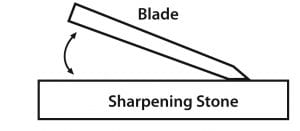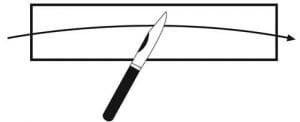Tips on Safety, Use, Maintenance, & Sharpening

(PDF Version)
Message to Parents
We encourage you to teach your son or daughter about knife safety and care as early as possible.
Begin by showing your child safe knife use in the kitchen.
It’s important that your children understand that a knife can be dangerous if not properly treated or
used carefully. Teach them how to sharpen a knife, cut properly, store the knives carefully, and respect knives as tools.
We believe it’s important that each child know that:
1) Knives are important tools, not toys.
2) Sharp knives are safe tools. Dull knives can be dangerous.
3) The sharp edge and point of the blade should always be pointed in a safe
direction.
4) There are places they should not take knives such as schools or school functions
because they are not allowed.
Learn more about the knife laws in your state or where you travel.
Introduction
Congratulations on owning your first knife! With it comes a feeling of pride in being considered mature enough to own and carry a knife. That ownership also brings with it a responsibility to use your knife safely and properly.
Like a hammer or saw, your new knife is a tool. It will require regular care, knowing what the knife can and cannot do, and understanding its proper uses. This is valuable advice and tips on how to get the most from your knife for many years.
Know Your Knife
Your “first knife” is more than just a sharp blade with a handle to hold on to. Your new knife may also include a screwdriver, file, scissors, tweezers, or other specialized tools. Your knife will either fold inside the handle or have a sheath to put it into when it’s not being used. This keeps the edge from becoming nicked and dulled. It also prevents accidents. The blade is made from a high-quality alloy steel. This steel is formulated to be strong, to hold its edge well, and to retain its bright, shiny finish with proper maintenance. You will need to clean, oil, and sharpen your knife regularly.
Safety
Always keep safety in mind when using your knife.
- Be sure to know how your knife works before using it. Practice safely opening and closing your knife.
- Always carry your knife with the blade shut or in a sheath.
- A sharp knife will always be safer and do a better job.
- Only use your knife to cut. Do not use it to hammer, pound, etc.
- Remember not to “chop” or strike objects to cut them.
- Never throw your knife (unless it’s specifically designed to do so).
- If the blade of your knife does not lock in the open position, do not put pressure on the blade in a direction that might cause it to close on your fingers.
- Always ask yourself “If my knife accidentally slips where will it go?” If the answer is “towards me or somebody else’s body,” change your position.
Maintenance
You’ll get the best service from your knife if it is kept in good shape.
- If the knife gets wet, remove all water and dry thoroughly.
- Use light oil to cover the blade and hinged parts.
- Wipe off all excess oil.
- Whenever the knife is not going to be used for a long period of time, make sure that the blades and working parts have a protective covering of oil. This will keep it from rusting.
- Never attempt to take apart your knife. doing so will result in an unsafe knife that may not be warrantied by the manufacturer.
Sharpening
It is easy to keep the blade sharp. Use a good sharpening stone or any of the commercially available sharpening systems. For the best results and safety, follow the directions for whatever system you choose. If you sharpen it regularly, only a few strokes will be needed to keep it sharp.
- Hold the blade at the angle suggested by the manufacturer. Maintain that angle while sharpening.
- Push the knife in the direction of the edge.
- Turn the knife around to the other side of the edge. Push the opposite direction, in the direction of the blade.
Always sharpen your knife away from your
body.
When sharpening on a sharpening stone, some  steel on both sides of the blade must be removed at a precise angle. Stroking the blade over the stone at a 10-15° angle slowly removes the metal. The metal is actually scraped from the blade making it sharper with each stroke as you push it across the stone as if you’re attempting to cut a thin slice from the stone’s surface.
steel on both sides of the blade must be removed at a precise angle. Stroking the blade over the stone at a 10-15° angle slowly removes the metal. The metal is actually scraped from the blade making it sharper with each stroke as you push it across the stone as if you’re attempting to cut a thin slice from the stone’s surface.
Outdoor Ethics
It is important to treat your outdoor surroundings with respect. Always leave the area the same as it was when you arrived, or in better condition. Read and abide by all of the rules and guidelines for any trails, lakes, or recreational areas.
An Educational Project of the American Knife & Tool Institute – With permission, based on My First Knife written by noted outdoorsman Tom Fegeley.
 AKTI is the credible source of valuable knife information. Carry and use your knives and edged tools with confidence.
AKTI is the credible source of valuable knife information. Carry and use your knives and edged tools with confidence.
Request printed copies to share.
(PDF Version)


 AKTI is the credible source of valuable knife information. Carry and use your knives and edged tools with confidence.
AKTI is the credible source of valuable knife information. Carry and use your knives and edged tools with confidence.